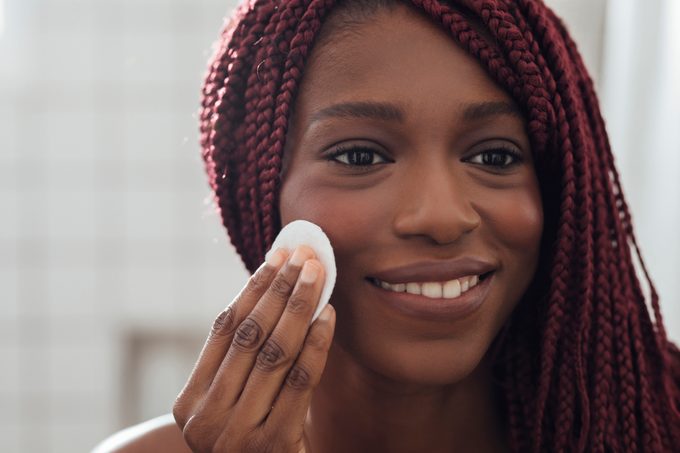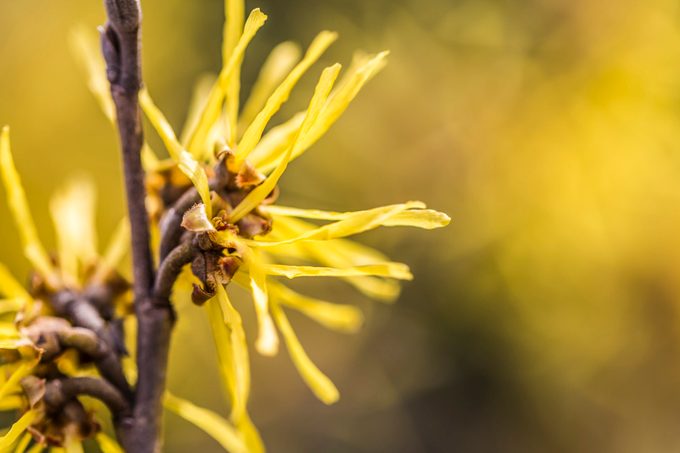7 Uses for Witch Hazel
Updated: Mar. 03, 2021
This common shrub has some uncommonly good health benefits.
One of the first home remedies in the United States was witch hazel—a shrub first used by Native Americans to treat a number of ailments, says Niket Sonpal, MD, assistant clinical professor at Touro College of Osteopathic Medicine. But researchers are just now discovering the different chemical compounds within the plant’s bark and leaves that help explain why witch hazel has been a go-to treatment for centuries for everything from infections to bug bites.
There are several different ways that witch hazel could benefit you. “Witch hazel is anti-inflammatory, antibacterial, possibly anti-viral, and an astringent,” says Ted Lain, MD, board-certified dermatologist and chief medical officer at Sanova Dermatology. But it definitely shouldn’t be applied at full strength. “As with all other natural or organic compounds, witch hazel is composed of numerous chemicals that can be damaging to the skin when applied at high concentrations.” Most commonly, it’s diluted into a cream or with water, alcohol, or a carrier oil, depending on whether it’s being used as a toner or ointment. But no matter how you use it, consult with your doctor before you use it to avoid potential interactions with your current treatment regimen.
Treat hemorrhoids
There’s a reason that common over-the-counter treatments like Preparation H tout witch hazel as a key ingredient—it’s really effective at soothing the main symptoms of hemorrhoids. “Witch hazel is believed to help treat the itching, redness, pain, and swelling associated with hemorrhoids due to its anti-inflammatory effects and can stop some minor bleeds from them as well,” Dr. Sonpal says. To use, swab the area with a cotton pad soaked in witch hazel after every bowel movement.
Calm an itchy or sensitive scalp
A study in the International Journal of Trichology suggests that using a witch hazel-based shampoo and tonic on the scalp may help reduce irritation and sensitivity. This was especially helpful for patients who were treating their hair loss with minoxidil, which could lead to an irritated scalp. Note this study is a retrospective observational study, not a controlled trial.
Subdue your acne
Witch hazel is a common ingredient in skin toners, and it’s considered a potent weapon against acne. “Witch hazel has antimicrobial properties as well as the ability to reduce oil and inflammation,” says Erum Ilyas, MD, board-certified dermatologist with Montgomery Dermatology, LLC. “These properties make it well suited to manage acne.”

Soothe insect bites
Those itchy red welts from bug bites can be soothed by a little swab with witch hazel. “Red skin from insect bites or other irritation has also been shown to benefit from witch hazel,” Dr. Sonpal says. “In fact, witch hazel has been shown to suppress erythema—a reddening of the skin caused by injury or irritation—by up to 27 percent. But it will dry the skin out a lot, and if there is an open wound it can burn or sting.”
Help heal eczema and skin rashes
It may seem counterintuitive to use an astringent on the rashy patches of eczema, but the American Academy of Dermatology says witch hazel is a potential eczema treatment. However, Dr. Ilyas says you need to pair witch hazel with something with soothing. “Eczema may be more difficult to manage with witch hazel alone, given its astringent properties. However, it may help to reduce inflammation in conjunction with other more hydrating products.” Doctors have also recommended using it for the early stages of diaper rash to help keep it at bay.
Soothe skin after shaving
Witch hazel’s anti-inflammatory and astringent properties make it an ideal product to splash on after shaving. “It helps with keeping razor bumps down, keeps the pores clean and tones the skin,” Dr. Sonpal says. “Its natural anti-inflammatory properties seem to make it a good fit for that.”
















